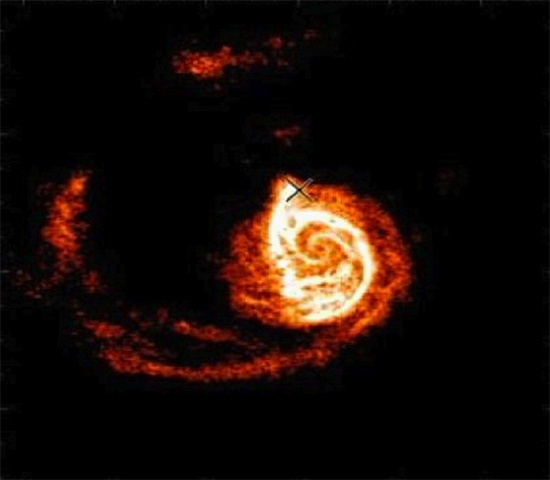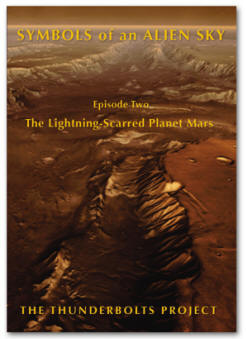|

H1 Hydrogen emissions in the M51
galaxy. Credit: Sukanya Chakrabarti/UC
Berkeley.
Dark Satellites
Apr 04, 2011
Are there dark matter galaxies
orbiting the Milky Way?
Sometimes, clues can be hidden in
plain site. The key to solving a
particular puzzle might simply be
clouded by a layer of presumptions
that obscure its true import. Such
appears to be the case according a
recent
press release announcing
the creation of a computer model to
predict the existence of satellite
galaxies.
Astronomers from the University
of California, Berkeley propose that
galaxies like our own Milky Way
should have "lots" of smaller
galaxies in orbit around them. Since
their existence cannot be determined
by visible light surveys, it is
thought that most of them are
composed of so-called "dark matter."
The research team developed a
predictive computer model that
analyzes H1 hydrogen distribution in
galactic discs. If they can find
disturbances in the structure it
might indicate gravitational
perturbations ("tidal effects")
caused by invisible galaxies.
The Milky Way is host to at least
two smaller companions, the Large
and Small Magellanic Clouds.
However, some astronomers suspect
that there are as many as 80 or
more. The new predictive model is
supposed to help answer the
question.
Gravitational force exerted by
this unseen and undetectable
material is thought to sustain not
just our galaxy, but all galaxies.
The supposed lack of luminous matter
that can be observed in the visible
Universe led to the original theory
of dark matter.
In 1933,
Fritz Zwicky was studying
the
Coma Cluster and found
that his calculations for orbital
acceleration and stellar mass were
off by a factor of about 160. He
concluded that there must be
something invisible to his
instruments somewhere within the
cluster that was holding it
together.
Dark matter is unseen and
undetectable and can be analyzed
through inference alone. Could it be
that something else is taking place?
Something that mainstream observers
fail to consider as an active force?
What about electricity?
Electric Universe theory sees
clusters of galaxies, the galaxies
themselves, and their associated
stars driven by electric currents
flowing in dusty plasma.
Birkeland currents create
z-pinch compression zones
between spinning magnetic fields in
an electrical vortex. Compressed
plasma forms electromagnetically
confined spheres, some in arc mode,
some in glow mode and some with
variability between the two states.
Cosmic Birkeland currents flow
into galaxies, so stars in their
discs are powered by those currents.
Galaxies, in turn, receive their
power from intergalactic Birkeland
currents that are detected by radio
astronomers in space as filamentary
structures traceable by their
magnetic fields.
Birkeland currents are drawn
toward each other in a linear
relationship, with a long-range
electric force attraction 39 orders
of magnitude greater than gravity,
although their magnetic attraction
is weaker. Dark matter and dark
energy influences can be dismissed
when electric currents flowing
through plasma are recognized.
When Birkeland currents interact,
they twist around one another,
forming a helix. If a cross section
could be taken through plasma
trapped in their interstices, it
would reveal the familiar
barred-spiral shape of a galaxy. In
the image of M51 at the top of the
page, the intertwining electrical
filaments are clearly visible.
As Hannes Alfvén postulated,
electricity flows into the poles of
a galaxy like the Milky Way and then
out through the spiral arms. The
circuit closes above and below the
galactic disk, flowing back into the
poles. This circuit receives its
driving power from Birkeland
currents that connect the galaxy
with the rest of the Universe.
The galactic z-pinch forms a
cylindrical particle beam, coaxial
with the galaxy and beyond the edge
of the disk, which would energize a
ring of stars.
Observations
from the Sloan Digital Sky Survey
have uncovered such a ring, a
separate structure that surrounds
the galaxy at a reported distance of
120,000 light years.
Instead of dark matter dwarf
companions, the Milky Way and other
galaxies most likely have
dark mode electrically energized
satellites.
Stephen Smith
Hat tip to Wal Thornhill
 New
DVD New
DVD
The Lightning-Scarred
Planet Mars
A video documentary that could
change everything you thought you
knew about ancient times and
symbols. In this second episode of
Symbols of an Alien Sky, David
Talbott takes the viewer on an
odyssey across the surface of Mars.
Exploring feature after feature of
the planet, he finds that only
electric arcs could produce the
observed patterns. The high
resolution images reveal massive
channels and gouges, great mounds,
and crater chains, none finding an
explanation in traditional geology,
but all matching the scars from
electric discharge experiments in
the laboratory. (Approximately 85
minutes)
Video Selections
Order Link
|





 New
DVD
New
DVD

